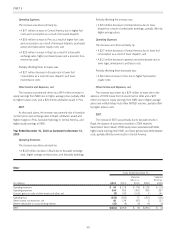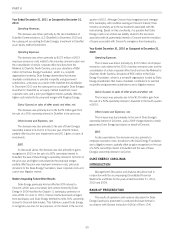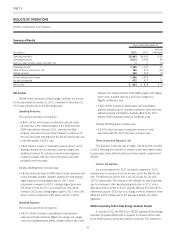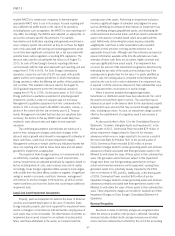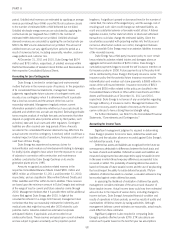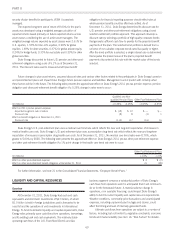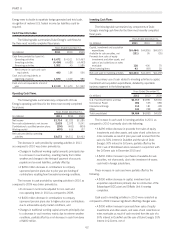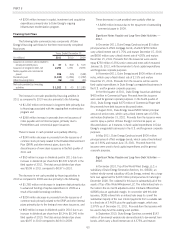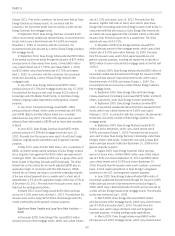Duke Energy 2011 Annual Report Download - page 79
Download and view the complete annual report
Please find page 79 of the 2011 Duke Energy annual report below. You can navigate through the pages in the report by either clicking on the pages listed below, or by using the keyword search tool below to find specific information within the annual report.
PART II
available at that time, including, but not limited to, income levels,
deductions and credits. In accordance with interim tax reporting
rules, a tax expense or benefit is recorded every quarter to adjust for
the difference in tax expense computed based on the actual
year-to-date ETR versus the forecasted annual ETR.
Duke Energy recognizes tax benefits for positions taken or
expected to be taken on tax returns, including the decision to exclude
certain income or transactions from a return, when a more-likely-
than-not threshold is met for a tax position and management believes
that the position will be sustained upon examination by the taxing
authorities. Duke Energy records the largest amount of the tax benefit
that is greater than 50% likely of being realized upon settlement.
Management evaluates each position based solely on the technical
merits and facts and circumstances of the position, assuming the
position will be examined by a taxing authority having full knowledge
of all relevant information. Significant management judgment is
required to determine recognition thresholds and the related amount
of tax benefits to be recognized in the Consolidated Financial
Statements. Management reevaluates tax positions each period in
which new information about recognition or measurement becomes
available. The portion of the tax benefit which is uncertain is
disclosed in the notes to the Consolidated Financial Statements.
Undistributed foreign earnings associated with International Energy’s
operations are considered indefinitely reinvested, thus no U.S. tax is
recorded on such earnings. This assertion is based on management’s
determination that the cash held in International Energy’s foreign
jurisdictions is not needed to fund the operations of its U.S. operations and
that International Energy either has invested or has intentions to reinvest
such earnings. While management currently intends to indefinitely reinvest
all of International Energy’s unremitted earnings, should circumstances
change, Duke Energy may need to record additional income tax expense
in the period in which such determination changes. The cumulative
undistributed earnings as of December 31, 2011, on which Duke Energy
has not provided deferred U.S. income taxes and foreign withholding taxes
is $1.7 billion. The amount of unrecognized deferred tax liability related to
these undistributed earnings is estimated at between $250 million and
$325 million.
For further information, see Note 22 to the Consolidated
Financial Statements, “Income Taxes.”
Pension and Other Post-Retirement Benefits
The calculation of pension expense, other post-retirement
benefit expense and pension and other post-retirement liabilities
require the use of assumptions. Changes in these assumptions can
result in different expense and reported liability amounts, and future
actual experience can differ from the assumptions. Duke Energy
believes that the most critical assumptions for pension and other
post-retirement benefits are the expected long-term rate of return on
plan assets and the assumed discount rate. Additionally, medical and
prescription drug cost trend rate assumptions are critical to Duke
Energy’s estimates of other post-retirement benefits.
Funding requirements for defined benefit plans are determined
by government regulations. Duke Energy made voluntary
contributions to its defined benefit retirement plans of $200 million in
2011, $400 million in 2010 and $800 million in 2009. In 2012,
Duke Energy anticipates making $200 million of contributions to its
defined benefit plans.
Duke Energy and its subsidiaries maintain non-contributory
defined benefit retirement plans. The plans cover most U.S.
employees using a cash balance formula. Under a cash balance
formula, a plan participant accumulates a retirement benefit
consisting of pay credits that are based upon a percentage (which
may vary with age and years of service) of current eligible earnings
and current interest credits. Certain employees are covered under
plans that use a final average earnings formula. Under a final average
earnings formula, a plan participant accumulates a retirement benefit
equal to a percentage of their highest 3-year average earnings, plus a
percentage of their highest 3-year average earnings in excess of
covered compensation per year of participation (maximum of 35
years), plus a percentage of their highest 3-year average earnings
times years of participation in excess of 35 years. Duke Energy also
maintains non-qualified, non-contributory defined benefit retirement
plans which cover certain executives.
Duke Energy and most of its subsidiaries also provide some
health care and life insurance benefits for retired employees on a
contributory and non-contributory basis. Certain employees are
eligible for these benefits if they have met age and service
requirements at retirement, as defined in the plans.
Duke Energy recognized pre-tax qualified pension cost of $45
million in 2011. In 2012, Duke Energy’s pre-tax qualified pension
cost is expected to be $17 million higher than in 2011 resulting
primarily from an increase in net actuarial loss amortization, primarily
attributable to the effect of negative actual returns on assets from
2008. Duke Energy recognized pre-tax nonqualified pension cost of
$11 million and pre-tax other post-retirement benefits cost of $26
million, in 2011. In 2012, pre-tax non-qualified pension cost is
expected to be approximately the same amount as in 2011. In
2012, pre-tax other post-retirement benefits costs are expected to be
approximately $8 million lower than in 2011 resulting primarily from
an increase in net actuarial gain accretion and a decrease in net
transition obligation amortization.
For both pension and other post-retirement plans, Duke Energy
assumes that its plan’s assets will generate a long-term rate of return
of 8.00% as of December 31, 2011. The assets for Duke Energy’s
pension and other post-retirement plans are maintained in a master
trust. The investment objective of the master trust is to achieve
reasonable returns on trust assets, subject to a prudent level of
portfolio risk, for the purpose of enhancing the security of benefits for
plan participants. The asset allocation targets were set after
considering the investment objective and the risk profile. U.S. equities
are held for their high expected return. Non-U.S. equities, debt
securities, hedge funds, real estate and other global securities are
held for diversification. Investments within asset classes are to be
diversified to achieve broad market participation and reduce the
impact of individual managers or investments. Duke Energy regularly
reviews its actual asset allocation and periodically rebalances its
investments to its targeted allocation when considered appropriate.
Duke Energy also invests other post-retirement assets in the Duke
Energy Corporation Employee Benefits Trust (VEBA I). The
investment objective of VEBA I is to achieve sufficient returns, subject
to a prudent level of portfolio risk, for the purpose of promoting the
59


